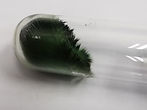Discovery Novel Magnetic Materials & Nanodevices
In our research group, Molecular Magnetic Materials Lab (M3-cubed), we are exploring Fe(II) and Fe(III) spin crossover systems with designed heterocyclic Schiff base ligands. We tune the electronic and steric properties of the ligand to access materials which show abrupt spin crossover close to room temperature. Recently, we extend our work toward nanodevices fabrication. This new avenue will give us opportunity to be one step closer to real world applications on smart sensors, high density memory storage.
Research //
SPIN CROSSOVER MATERIALS
Fe(II) SPIN CROSSOVER
In the case of Fe(II), the ligands we are exploring are based on imidazole and these complexes show spin crossover above, below and at room temperature. In switching from the HS to the LS state the complexes show a dramatic colour change from orange to deep red or purple. The reason for the change in colour is that the gap between t2g and eg* set is larger in the LS state.

Fe(III) SPIN CROSSOVER
Iron(III) spin crossover complexes have the advantage of being air stable and are consequently easily developed into future materials. Using principles from crystal engineering we are exploring a new series of designed spin crossover compounds which exhibit abrupt and hysteretic spin crossover.
Structural studies of spin crossover compounds form an essential part of understanding how to design better spin crossover systems. In cases where the structural data of the complex before, during and after spin crossover are available it’s clear that large changes take place at the metal centre.
MOLECULAR CLUSTERS
SINGLE MOLECULE MAGNETS
Molecular clusters are molecules containing three or more metal atoms. As well as being of biological interest, many enzymes contain small metal clusters, they can also exhibit fascinating magnetic behaviour.
A family of particular interest are single molecule magnets (SMMs). SMMs exhibit slow relaxation of magnetization and consequently become trapped in one magnetic state. This allows them to be used as molecular switches.
In this area our group has been working Fe and Co clusters with more diverse and designed ligands in an attempt to more effectively control the shape and nuclearity of the clusters.

Molecular Devices
In the M3-cubed Lab, we are particularly interested in Fe(III) spin crossover molecules as these are chemically robust, stable under ambient conditions and our group now has a range of compounds with different magnetic characteristics that can be used. We aim to use simple junction fabrication techniques, taking advantage of supramolecular principles to attach the molecules to the surface. Moreover, employing the rarely used EGaIn electrode in junction fabrication we intend to minimise junction failure and the, often neglected, impact of the top electrode on modifying magnetic behaviour.

CRYSTAL ENGINEERING
Crystal engineering is one of approach that we use to gain more understanding of coordination compound properties. Ligand design is one of the key of success in our group for controlling the inter, intra molecular interactions.

SPIN CROSSOVER NANOMATERIALS
Nanomaterials are expected to form the basis of technological materials in the future. Nanomaterials developed from our molecular systems allow the design of truly functional devices. These nanomaterials vary in shape from spheres to cubes to rods. Thin films are also accessible and represent a promising alternative to current technology.

ELECTROCHEMICAL STUDIES
We are exploring the possibility of using the spin crossover compounds for modification screen printed graphene electrodes. This work we are collaborate with Dr. Adisorn Tuantranont, the Principal Researcher and Lab Director; Nanoelectronics and MEMS Laboratory, National Science and Technology Development Agency.

